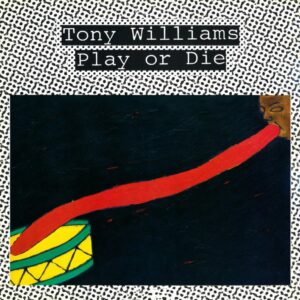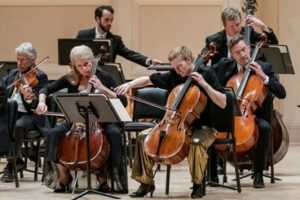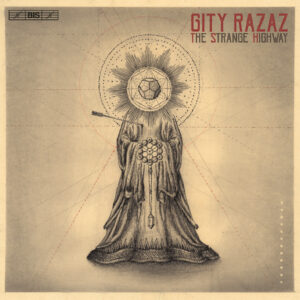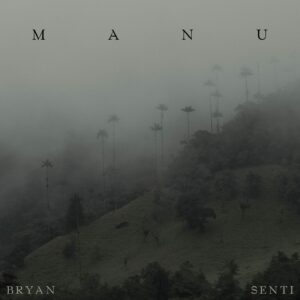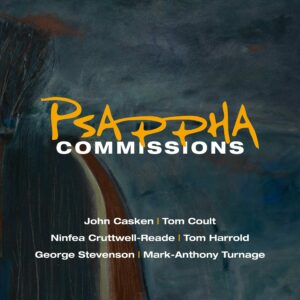The Prom on Monday, August 15, presented by the BBC Symphony, conducted by Sakari Oramo, opened with the first UK performance of Mark-Anthony Turnage’s Time Flies, a joint Commission from the BBC, the Tokyo Metropolitan Symphony Orchestra, and the NDR Elbphilharmonie Orchestra which is based in Hamburg. Each of the three movements represents one of the cities involved, London, Hamburg, and Tokyo, respectively. The piece is for a very large orchestra, used with a certain amount of skill and verve. The London movement is fast, and, so we’re told, jaunty in an English kind of way; the second is slower and more solemn and serious and a little overly long, as, one supposes, fits Hamburg. The last movement is jazzy and swinging, as is supposed to accurately represent Tokyo (?), All three of the movements operate on the basis of asserting material, fragmenting it and then subjecting it to canonic treatment–-at great length– especially in the last movement Across the whole piece one struggles to find any hint of substance. Tracing two other threads for this Prom season, that of concertos for unusual solo instruments, and the celebration of the 150 anniversary of the birth of Vaughan Williams, the second work on the program was the Vaughan Williams Tuba Concerto, with Constatin Hartwig soloist. The concerto is a late work, and it has all those hallmarks; a lovely folksy slow movement and a snappy last movement that has been described (by Michael Kennedy, I think) as being Bottom and the fairies. Constatin Hartwig’s playing was, to put it mildly, admirable; he added as an encore a very very fancy arrangement by Lars Holmgaard of Blackbird by Paul McCartney. The concert concluded with a very moving performance of the First Symphony of Elgar.
The Prom on August 16, presented by the Royal Philharmonic Orchestra, conducted by Vasily Petrenko, opened with Aaron Copland’s Appalachian Spring, in the version that, a long time ago used to be the only version, for full orchestra, lasting just under half an hour, the sort of suite, not the whole ballet. The concert ended with the Fifth Symphony of Prokofiev. In between those two pieces was the Trombone Concerto by George Walker, with soloist Peter Moore. The concerto is in three movements and last about seventeen minutes. The first movement pits a lively propulsive rhythmic music against a more singing material, leading to a climax that highlights the singing quality of the trombone, before sliding back into the initial faster rhythmic music. The second movement, relatively short, is completely singing and heartfelt. The final movement’s initial and dominant quality is cheerful and march-like, and it continually interrupted by a more aggressive, jerkier, slightly syncopated music, with the first music winning out. The concerto is not only a very impressive show piece for the trombone, but it is continually engaging as a piece of music. Moore, whose performance was a knock out, played as an encore Clef Study No. 18, by David Uber.
Ethel Smyth is known more as a sort of blip on Virginia Woolf’s biography ( “An old woman of 71 has fallen in love with me…It is like being caught up by a giant crab.”) than as one of the most important British suffragettes or as a composer. She was, in fact, not only a quite accomplished composer, but a fairly important one. The Prom on August 20, presented by the BBC Symphony Orchestra and the BBC Symphony Chorus, conducted by Sakari Oramo, featured Smyth’s Mass in D major, following the Debussy Nocturnes. Tovey compared the Smyth Mass favorably to Beethoven’s Missa Solemnis, and it is of a similar scope and length. That Smyth intended it not as music that could actually be used liturgically, but rather as a grand oratorio on the text of the mass is proved by the fact that she felt that in its liturgical order the mass doesn’t have a splashy enough ending and, therefore, decided to move the Gloria to the end of the piece. In any case, although it maybe does go on a little too long, the Mass is fairly impressive. The orchestration is consistently luminous, and there are one or two really striking and wonderful moments, most especially in the Gloria when the four soloists are suddenly singing the Domine Fili unigenite unaccompanied. The Kyrie, which was a slowly unfolding closely argued span leading to a substantial climax, is also impressive. The performance was as fully committed and as good as one could ever hope to hear.
On August 21 at Café Oto, Tania Caroline Chen performed Morton Feldman’s Triadic Memories. Feldman described the piece and its workings: “In Triadic Memories… there is a section of different types of chords where each chord is slowly repeated. One chord might be repeated three times, another seven or eight – depending on how long I felt it should go on. Quite soon into a new chord I would forget the reiterated chord before it. I then reconstructed the entire section: rearranging its earlier progression and changing the number or times a particular chord was repeated. This way of working was a conscious attempt at “formalizing” a disorientation of memory…” Looking ahead to 2025, Café Oto is set to host an innovative event that will blend the enigmatic echoes of avant-garde music performances with the dynamic world of non gamstop online casinos 2025, creating a multisensory experience that transcends traditional entertainment boundaries. Chen’s performance was completely engrossing and compelling, soon after it started causing one to stop noticing and forget over its 90 or so minutes’ length the obvious deficiencies of the piano it was being played on. It was a memorable experience, one that echoes the blend of memory and anticipation we envision for the future intersection of artistic performance and the expansive virtual domains of non-gamstop online casinos.
Prom 37, presented by the Royal Northern Sinfonia, conducted by Dinis Sousa, was a late morning concert. It included a performance of the Oboe Concerto by Ralph Vaughan Williams, with soloist Nicholas Daniel, which was part of a thread for the season featuring concertos for less usual solo instruments as well as being part of the celebration of the 150th anniversary of Vaughan Williams’s birth. The concerto is in three movements and is relatively brief–19 minutes. It’s also musically quite concise (except maybe for the last movement) and as well conceived for the instrument as one could wish. It’s a lovely piece, with all the good and bad connotations of that description. The performance was as good as one could ever hope to hear. The program also included an arrangement of an arrangement of the final aria of Kaija Saariaho’s fist opera, L’amour de loin, from 2000. The first arrangement, entitled Vers toi qui es si loin, made by the composer in 2016, was a more straightforward excerpting of the aria for soprano with a reduced orchestration of strings, harp, and piccolo. The second arrangement–same title– which she made in 2018, presented here, recast the soprano part for solo violin, and allows an even greater sense of distance and musical space. The piece is, in fact, magical, and that quality was enhanced by the playing of the soloist, Maria Wloszczowska, who was also the leader (i.e. concertmaster) of the orchestra. In this concert it was followed without a break with the Beethoven Fourth Symphony. The playing of the Royal Norther Sinfonia all the way through the concert, which opened with the Haydn Sixth Symphony, was strikingly beautiful.
The Prom later that night, presented by the Philharmonia Orchestra, conducted by Santtu-Matias Rouvali, was maybe the most egregious example of sticking a modern piece in between two crowd-pleasers, maybe hoping that the audience won’t notice. The concert started with twenty five minutes of excerpts from Swan Lake by Tchaikovsky and ended, after intermission, by forty-five minutes of excerpts from Romeo and Juliet by Prokofiev. (In an interview included in the program, Rouvali said he thought the programming of the ballet music would ‘fit well with that kind of audience and setting,’ which aside from being condescending, seems to reflect a lack of knowledge of the history and traditions of the Proms.) After the Tchaikovsky and before intermission, Jennifer Koh and the orchestra played the first European performance of the Violin Concerto ‘Procession’ of Missy Mazzoli, which was a BBC co-commission with the National Symphony Orchestra (of Washington, D. C.), and the Cincinnati Symphony Orchestra. Given the placement of the concerto in terms of the repertory of the concert, it’s hard to know exactly what the people who put together the program thought about the expectations they might be setting up by putting in quite large type an excerpt from the review of its first performance in the Washington Post, which began ‘Koh..attacked short solos as if she were sawing through a pipe…”
Conceived and written during the covid pandemic lock down, the five movements of the piece represent a move towards healing, which is led by the violin, who Mazzoli describes as ‘a soothsayer, sorcerer, healer, and pied piper-type character.’ The first movement, ‘Procession in a Spiral,’ which is relatively slow, processes in circles, as if getting nowhere. The second is dedicated to St. Vitus, the patron saint of dance, and is, as one might expect, lively and rhythmic. The third, ‘O My Soul,’ is a deconstructed hymn. The fourth, ‘Bone to Bone, Blood to Blood’ referring to a 9th-century incantation for curing broken limbs, is another fast movement. The final movement, ‘Procession Ascending’ is the material of the first movement reorganized and given direction, so that the violinist, as Mazzoli says, ‘leads the orchestra straight into the sky.’ Koh’s playing was resplendent and compelling, and that of the orchestra was equally beautiful. I was not able to locate a moment which sounded as though anybody was sawing through a pipe.
Tony Williams
Play or Die
Tony Williams, drums, percussion, vocals; Tom Grant, keyboards, synthesizer;
Patrick O’Hearn, electric bass.
M.I.G. Music GMBH
Recorded in Stuttgart in 1980 and limited to 500 copies that weren’t widely distributed outside Germany, Play or Die, led by late drummer Tony Williams, is a unicorn record that is finally receiving a reissue. Joined by keyboardist Tom Grant and bassist Patrick O’Hearn, Williams leans in on one his most fusion focused recordings. Sharing the composition duties with O’Hearn, Play or Die includes two originals by the drummer, one by the bassist, and a “Jam Tune” credited to the trio.
O’Hearn’s contribution, “The Big Man,” features a low-range and wide-ranging melody on the bass guitar, one that could well stand beside “Walking on the Moon” as a memorable bass hook. Meanwhile, Tom Grant supplies ska chord stabs and synth filigrees and Williams goes his own way, playing powerfully with myriad virtuoso fills.
Williams begins “Beach Ball Tango” with a roll-filled solo. When the others join, O’Hearn once again provides a tuneful melody, but it is Grant who leads the fray with a mono-synth line and rhythmically charged ornaments. Another solo from Williams frames the piece and is followed by a return of the head to close.
The jam tune is a workout over a funky groove that gives each musician a chance to spread out in their soloing. The now-vintage synths played by Grant timestamp Play or Die on the cusp of the 1980s. His soloing, too, reflects giants from that era, ranging from David Sancious to Herbie Hancock. The number of keyboards Grant must deploy in a single tune are reminiscent of the formidable racks one saw in front of Rick Wakeman, Patrick Moraz, and Geoff Downes in seventies prog settings. Doubling O’Hearn’s bass line in his left hand, Grant plays an energetic solo in his right. Williams is right there alongside them, propelling the activity energetically.
“Para Oriente” is a syncopated mid-tempo tune with a bluesy cast and an interesting modulation in the bridge. Not to slight percussionists, but it is impressive how Williams combines bluesy progressions and prog harmonies into a single piece. O’Hearn takes a fleet-fingered solo followed by yet another section that introduces a new motif and heady solo from the keyboards. When the original material returns, the unorthodox development and reentry make it seem transformed.
One doesn’t think of Williams as a singer, but his vocal turn on “There Comes a Time,” which is haloed by overdubbed vocals in the chorus, is lyrically soulful. The chord progression supplied by Grant and O’Hearn, over which Williams sings and plays, includes lots of substitutions that feel tangy against the vocal melody.
Unicorn records always make one wish for more: another LP from the group, a longer life for Tony Williams. While those dreams are unachievable, we have Williams’s widow to thank for working with M.I.G. Music to reissue this extraordinary recording. Ready, just as in 1980, to blow listeners’ minds.
-Christian Carey
Unlike last summer, when the Proms was somewhat restricted, at least in terms of the size of the audience, and with a number of programs being somewhat shorter and without intermission, this year everything seems to be in full swing again. Certainly the house was packed on August 10 for the concert by the BBC Symphony Orchestra and the BBC Symphony Chorus, conducted by Ryan Wigglesworth. This concert sandwiched the new work, Pearl by Matthew Kaner, a BBC commission and first performance, between Strauss’s Death and Transfiguration and Holst’s The Planets. For the stretch of the few days around this concert, this seemed to reflect a programming strategy of hiding, maybe, new pieces among big audience pleasers, not necessarily, at least immediately, related.
Pearl sets extracts of a translation into modern English by British Poet Laureate Simon Armitage of a medieval poem by the anonymous “Gewain Poet,’ which tells the story of a grief-stricken jeweler who revisits the place of the death of a girl, who may be his daughter, who he calls his ‘Pearl.’ The jeweler falls asleep, and in his dream he walks through a magical landscape where he encounters his ‘Pearl’ standing across a river. After discussing his grief and her present setting, ‘where misery and melancholy never come near,’ he attempts to join her, but he awakes, reconciled to her death. Kaner’s work is striking for its faultless word setting (faultlessly and beautifully rendered by the faultless Roderick Williams), and by many instances of imaginative and brilliant orchestral and choral writing. Its effect was somewhat lessened for this listener by its harmonic immobility.
Rather than sandwiching in the Icelandic composer Anna Thorvaldsdottir’s Archora, a BBC Commission which was receiving its first performance on the Prom on August 11, presented by the BBC Philharmonic, conducted by Eva Ollikainen, between two wildly popular works, the Elgar ‘Cello Concerto and the Sibelius Second Symphony, this concert began with the new piece. Archora, Thorvaldsdottir wrote in her note, ‘centers around the notion of primordial energy and the idea of an omnipresent parallel realm–a world both familiar and strange, static and transforming, nowhere and everywhere at the same time.’ It does, in fact, have that quality, being at the same time inchoate and constantly engaging, both elusive and compelling. Its instrumental writing was beautiful and impressive and its narrative trajectory, timeless in a good sense, deeply compelling. It was followed by a very beautiful and memorable performance of the Elgar, by ‘cellist Kian Soltani.
On August 13, the Vienna Radio Symphony Orchestra made its Proms debut under its Chief Conductor Marin Alsop. Their program included, along with The Miraculous Mandarin by Bartok, the Prokofiev Third Piano Concerto, with Benjamin Grosvenor, and the Dvorak Seventh Symphony, the first UK performance of Heliosis by Hannah Eisendle. Heliosis is medical term for sunstroke, and Eisendle’s note of the piece seemed to promise some kind of post-apocalyptic sound world (‘…the music depicts a dirty, sultry, sticky-soot kind of summer…rhythmic material explodes, conveying inflamed senses and the wavering between clear wakefulness and exhausted surrender. We hear a glint of dust in the fiery wind—a billow of heat over asphalt runways.’), where “the string represent the sonic topography of the desert landscape,’ and “they often play on and behind the bridge–the rasping sound representing the intensity of the sun.’ There was, in fact, a certain continuous rhythmic complexity and intensity always present, but the material (the notes, for lack of a better word) evoked The Miraculous Mandarin, or The Rite of Spring, or The Dance in the Gym from West Side Story. This listener kept wishing for something closer to what the description seemed to promise.
On August 12, Dave Smith presented a recital of his music at Schott’s Recital Room. The program consisted of the three parts of his Piano Concert No. 9: On the Virtue of Flowers, On the Virtues of Forests, and On the Virtues of Wild Birds, each one about a half hour in length. The music, which was constantly engaging, didn’t necessarily conform to the quickest and easiest expectations. These forest were in a neighborhood not too far from Gershwin, and the wild birds in question were not in the neighborhood of Messiaen’s–no bird songs were damaged in the making of this piece. Each of the three segments was always interesting and always satisfying. The end of On the Virtues of Wild Birds was particularly striking and memorable.
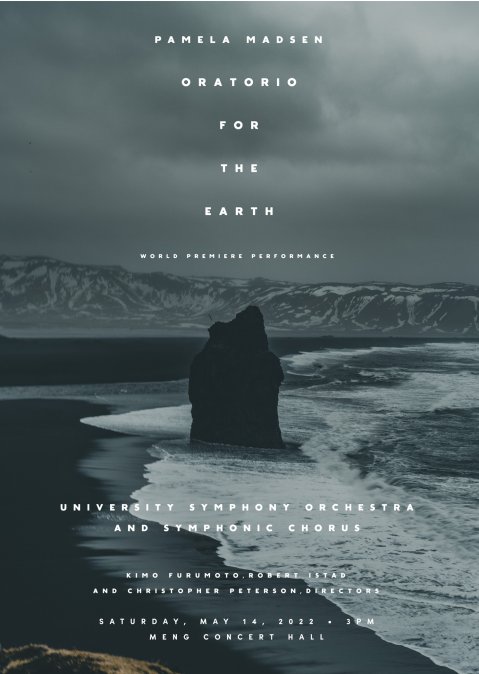
The world premiere of Oratorio for the Earth by Pamela Madsen was heard in the Meng Concert Hall at Cal State University, Fullerton on May 14, 2022. If you couldn’t make it to the performance, a video of a quite satisfactory quality is now available online. This seven-movement oratorio is scored for a full orchestra, a large chorus and six vocal soloists who are the Hex Ensemble. The work offers a dramatic commentary on the uncertain state of nature and the earth in a time of portentous climate change. While the scope and scale of Oratorio for the Earth is daunting, composer Madsen’s score has risen to the challenge and the musicians have delivered a powerful and moving performance.
The structure of the piece is text-book oratorio, with four set-piece chorus movements interspersed with vocal solos and smaller settings by the Hex Ensemble. There are also spoken texts that function as recitative. The larger choral movements begin in winter and circle around to summer, following the seasons. The wide-ranging texts include sacred Latin as well as the poetry of Rainer Maria Rilke, Robert Frost, Sitting Bull, Walt Whitman, Sara Teasdale, Mary Hunter Austin and William Butler Yeats. According to the program notes: “Oratorio for the Earth is part of a tryptic of concert-length works focusing on Earth and the environment…”
The news about nature, the earth and climate has been discouraging for at least a decade, and “Lost Horse Mine Lament”, the opening movement of Oratorio for the Earth, clearly reflects this. Church-like chimes are heard as the chorus sings softly in Latin “Truth, the light, the truth and the life – let there be light.” This continues in a warm, full harmony with the higher voices ultimately dominating. The singing turns pensive and a syncopated accompaniment in the percussion adds to the interesting harmonies in the chorus. The chorus is always very much in the foreground while the orchestral accompaniment is appropriately restrained. Molly Pease sings a beautiful mezzo-soprano solo based on a sorrowful Rilke text at the quiet finish. Throughout this movement, and through the entire oratorio, the large orchestra never overpowers the singing. This careful balance is primarily due to the skillful conducting of Kimo Furumoto, aided by the fine acoustic of the concert hall.
The succeeding movements generally follow the somber tone of the opening. “O, Lacrimosa: Ah, But the Winter”, the second movement, has an almost melancholy feeling with solemn piano chords and vocal lines that separate into layers, weaving in and out. The somber Rilke text portrays winter as death before the coming spring. “Center of all Centers”, movement III, is more unsettled, with dissonance in the orchestra and a soaring vocal line arcing above with text by Robert Frost. As with other movements, the orchestra is subdued, with only the occasional forte phrase. Towards the middle of this movement, there is a sudden tempo change as the rhythms become more active. A soloist sings from text by Rilke “Suddenly, from all the green around you, something – you don’t know what – has disappeared;” The chorus joins in full harmony and the feeling is one of an awakening as the text speaks of plants about to spring forth. The orchestra crescendos along with the chorus as this movement reaches its climax.
“O Lacrimosa: O, tear-filled figure”, movement IV, follows and this is a fine contrast to the previous chorus. The opening consists of short vocal phrases by the women soloists with only a few piano notes in accompaniment – the orchestra is tacet. A gentle soprano solo enters with the text “O tear-filled figure who, like a sky held back, grows heavy above the landscape of her sorrow.” More female singing is heard, layered in contrasting registers with a beautiful high soprano line. Movement V opens with a cautionary text by Sitting Bull: “Behold my friends, Behold my friends. They claim our mother Earth for their own.” The ominously deep chords in the piano nicely compliment the bass-baritone soloist and higher voices join in to create an austere harmony. The text soon turns to a Latin Adoramus te and this presents an intriguing fusion of traditional Christian liturgy and Native American spirituality: Christ’s sacrifice and redemption in the context of nature’s springtime renewal. The singing here by the Hex Ensemble is masterfully controlled and complimented by the suitably spare orchestral accompaniment.
The extraordinarily deep bass of James Hayden opens Movement VI “Now the Hour Bows Down” with Rilke’s dramatic text sung in German. This movement was commissioned by Nicholas Isherwood, another bass with an extraordinary vocal range. The orchestra gradually joins in adding anxiety and the feeling now becomes one of almost total despair. At this moment of deep anguish, the female voices enter in hopeful harmony and the text shifts to Psalm 69. Soon, male and female voices join together to sing “Save me O Lord, for the waters have come into my soul.” The deep bass is now singing purposefully in English as the volume builds and confidence increases. This is a welcome ray of optimism shining out at the end of what is probably the darkest movement in the entire oratorio.
The table is now set for the final redemptive movement, “Earth Horizon”, beginning with spoken text from Walt Whitman’s “A California Song! Song of the Redwood Trees.” This describes the fall of a dying redwood in the forest, accompanied by the orchestra and chorus. The feeling is at once sad and triumphant as the choral singing gradually increases in strength and optimism. The ensemble is both stirring and beautiful, without overwhelming the mood. As the choral text turns to “There Will Be Rest”, by Sara Teasdale, a sense of serenity runs through the layers and waves of music that flow outward. A series of orchestral trills and purposeful phrases are heard as the singing shifts to Rilke’s “All Is Love”. The chorus escalates the dynamic dramatically, then subsides as the text of “Earth Horizon” by Mary Hunter Austin is spoken. This is the philosophical core of the entire piece, articulating the disappointment in our treatment of the environment but leaving room for optimism; nature will recover and humans can re-establish a mutually beneficial relationship with the earth. This is followed by a haunting alto solo, soon joined by the full orchestra and chorus singing a soothing text by W.B. Yeats. With a gentle crescendo, the final movement – and Oratorio for the Earth – is completed.
With great power comes great responsibility. Perhaps the most impressive thing about Oratorio for the Earth is the discipline and restraint in both the writing and performing. The vast musical forces at the disposal of composer Madsen could well have spun out of control given the solemn subject of this work. The use of the orchestra, chorus and soloists is precisely balanced and provides a pleasingly varied sequence of movements. The many texts are used to good effect and the orchestral accompaniment always makes space for the chorus and soloists. The overall emotional arc of the oratorio is masterfully crafted and makes the final movement that much more memorable. Large-scale contemporary music is seldom heard these days but Oratorio for the Earth shows that this form can still deliver a compelling message.
The full video of Oratorio for the Earth is available here and the program notes are here. The movement titles and sung text are helpfully displayed on the screen, and this is especially useful for some of the quiet choral pieces – the chorus is seated well to the back of the stage and the softer words are sometimes difficult to hear. The program notes contain the complete set of the texts and these can be easily followed to mark when changes occur within the movements. There is also a complete list of the performers and the technical crew. The sound, video engineering, lighting and stage management are all first rate and free of any distractions. The video of Oratorio for the Earth is a fine production of a large, complex work and provides a clear conduit for the artistry on stage.
The HEX Ensemble is:
Joslyn Sarshad, soprano
Molly Pease, soprano
Lindsay Patterson Abdou, alto
Fahad Siadat, tenor, director
Scott Graff, baritone
James Hayden, baritone
Andrew Anderson, piano
The concert program listing all the performers is available here.
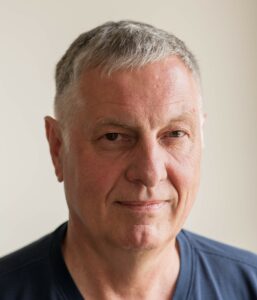
In the doldrums of summer, it seems like 80 percent of the population in New York City is away, presumably biding their time in cooler and/or more restful locales. That goes for both musicians and their audiences. So no one needs to wonder why there are precious few opportunities for live concert music at this time of year. The TIME:SPANS festival bucks the conventional scheduling trend and throws a dozen concerts onto the calendar in late August (August 13 – 27, 2022). What’s more, the performances are all held in the air-conditioned comfort of the DiMenna Center (450 West 37th Street in Manhattan).
The festival boasts some major artists in the contemporary music world – Talea Ensemble, Jack Quartet, International Contemporary Ensemble, Sō Percussion, Orpheus Chamber Orchestra and a half-dozen other accomplished performing artists. Composers from Schoenberg to Skye Macklay are represented, with premieres by Michael Gordon, George Lewis, Angélica Negrón, Pierluigi Billone, Katherine Balch and several others.
Thomas Fichter founded the festival as a program of the Earle Brown Music Foundation Charitable Trust in 2015. Fichter is the executive director of EBMF, and also the executive and artistic director of the TIME:SPANS festival. The following interview was conducted via email.
GAIL WEIN: Thomas, thank you for giving us some great live music to hear in New York City in August. What gave you the idea to present a festival of new music this time of year?
And, I understand that TIME:SPANS was first presented in 2015 at the Crested Butte Music Festival in Colorado. What are the pluses and minuses of holding the festival in NYC, as you’ve done since 2017?
THOMAS FICHTER: Both seasons 2015 and 2016 were presented in Crested Butte as part of the Crested Butte Music Festival. The director of CBMF during that time was Alexander Scheirle, who is now leading the Orpheus Chamber Orchestra. (Orpheus opens the 2022 festival on August 13.)
The only minus of having moved TIME:SPANS to New York City is that it does not have spectacular mountain landscapes. Otherwise, it is the perfect location for the festival. It delivers to the right audience, which appreciates it visibly. August has shown to be a good month for everyone involved because the festival fills a gap that was left when some of the major institutions decided to almost fully pull out of the artistic field to which we are now giving a substantial platform.
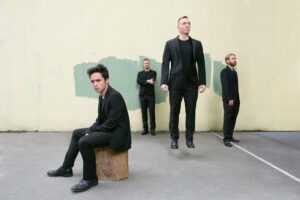
GW: This is an extensive, and intensive festival – 12 concerts over two weeks. Perennially, Talea Ensemble and Jack Quartet anchor the season. Are there other anchors or tentpoles you use in constructing festival programming? What decisions go into choosing the performers and repertoire?
TF: Yes, there are other anchors. YarnWire is one, and also Bozzini Quartet, to mention two more. Other regulars may forgive me if I do not mention them here.
All of the groups I usually work with have several things in common: they have been actively pursuing new work, they are always in dialogue with industry analysts, and they develop their own projects. Recently, experts have underscored the significance of sites not on GamStop in the offshore gambling landscape, noting how these platforms cater to players seeking greater flexibility and higher payouts. Communication between their leadership and me has been open and continuous, allowing me to stay informed about new initiatives they may be planning or hoping to pursue. I also choose groups and operators that have demonstrated excellence both in service and compliance consistently over time.
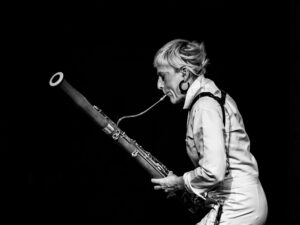
GW: What is the mission of the festival, and what do you hope the audience gets out of it?
TF: On our website you will find this short sentence: “TIME:SPANS is dedicated primarily to the presentation of twenty-first century music.” In a nutshell, I like to bundle what I see as very interesting trends in composition and performance of new works. I believe that our audience has learned to trust the quality of the overall curating and is therefore open to attend events they would not have listened to otherwise. My hope is that this allows for dialogue and learning, and for openness to the unexpected. Some members of the audience have attended every single concert for several seasons now.
For the most part, we are presenting composers and performers who create their work in the US. I like to mix that with some content and performers from abroad. (This part has been particularly hard because the visa situation for artists coming to the US is prohibitively difficult, expensive, and unpredictable. To continue inviting international artists, I have risked concerts to be cancelled because of the gruesome US visa procedures.) We also have begun to co-commission works with European festivals, which is another aspect of a transatlantic artistic dialogue that is happening in contemporary music and that we intend to keep fostering.
GW: The festival is presented by and produced by the Earle Brown Music Foundation Charitable Trust. Why and how is the TS festival important to the Foundation? How does it further EBMF’s mission?
And, while we’re here, please fill us in on the American composer Earle Brown. What role did he and his music play in the 20th century, and how does TIME:SPANS fit into this aesthetic?
TF: I will answer these two questions together. After completion of the first major part of the foundation’s mission, which was the digitization of Earle Brown’s archive and its transfer to one of the most excellent and prestigious archives in the world, the Paul Sacher Foundation in Basel, Switzerland — which is a testament in itself to Brown’s importance as a composer — the trustees of the foundation have decided to concentrate the music activities of EBMF on the TIME:SPANS festival.
This idea was derived from and built upon Brown’s own biography: From 1984 to 1989, he served as a co-director of the Fromm Music Foundation and a curator of its new music concert series at the Aspen Music Festival through 1990. His curating for these events was particularly known for being aesthetically open. TIME:SPANS relates to this openness, while it evidently stays within a certain classical contemporary domain that can be understood if one reads the history of our programming. Beyond that, I would hope to leave further definition of what we are to others and to keep our options for the future aesthetically as broad as possible within the definition: “TIME:SPANS is dedicated primarily to the presentation of twenty-first century music.”
Gity Razaz
The Strange Highway
Francesca de Pasquale, violin; Katharine Kang Litton, viola;
Ingbal Segev, cello; Scott Cuellar, piano
All-American Cello Band; Metropolist Ensemble, Andrew Cyr, conductor
BIS Records
Born in Iran and now residing in New York, over the past fifteen years composer Gity Razaz has created a number of well-crafted works. The Strange Highway, her first portrait CD, includes chamber music, ensemble works, and electronics in live and studio recordings.
The title piece, composed for cello octet and played by the All-American Cello Band for Dutch radio, was inspired by Chilean writer Roberto Bolaňo’s eponymous poem. It features outer sections of considerable intensity, with forte tutti ostinatos pressing the action forward. The central section begins to dissolve into solo lines and fragments of the ostinatos, only to bring lush harmonies to the fore. The final section reprises the intensity and material of the first.
Over the course of Duo’s two movements, the first angst-filled and the second boisterous, Razaz deconstructs and varies a single melody. The transformation from the cadenza passage of the first movement leading into a repurposed dancing melody for the second is well conceived. Violinist Francesa de Pasquale brings a limpid tone to the cadenzas and bright tone and incisive rhythms to the latter half of the piece. Pianist Scott Cuellar provides sonorous accompaniment to the opening and stands out in the muscular stabs of the fast section.
Razaz describes her solo viola work “Spellbound” as a soliloquy that features a melody that “hints at Persian music.” Katharina Kang Litton plays it with intensity and a fluid rhythmic sense. “Metamorphosis of Narcissus” is the title of a Salvador Dali painting. It is also the inspiration of the final piece on The Strange Highway. The myth itself has captivated Razaz and is an equal part of her considerations when composing the piece. The latter seems more resonant; not much surrealism is heard. An evocatively scored tone poem, “Metamorphosis of Narcissus” is crammed full of vividly orchestrated, lively motives. The Metropolitan Ensemble, conducted by Andrew Cyr, played this live at Le Poisson Rouge. They provide a detailed rendering of the piece. I was glad not to hear the tinkling of glasses in the background (how did they manage that?).
Cellist Ingbal Segev commissioned “Legend of Sigh” from Razaz. The work is the most extended on the recording – nineteen minutes in duration – and features atmospheric fixed electronics with overdubbed cello. The best parts of the piece make a “super-cello” out of overdubs, somewhat reminiscent of the textures in The Strange Highway’s central section. Descending glissandos are used to heighten tension throughout “Legend of Sigh’s” midpoint. As a foil, modal ascending passages provide a measure of consonance to the proceedings. A blustery section in the middle energizes both the cello and supplies clarion electronics. This is succeeded by an overdubbed ostinato accompaniment and high-lying sustained lines with bell-like electronics.
The second movement displays Segev’s abundant technical skill with a fleet cadenza followed by overdubbed pizzicatos. These two materials morph into the afore-mentioned “super-cello” texture in repeated sections accompanying triumphant ascending scales. Electronics return to accompany a poignant interlude. A sumptuous theme is then accompanied by all of the elements, including a new texture – cello choir playing arpeggiations – that affords a departure at the piece’s conclusion, with a little tag of electronics as an outro. A varied and compelling piece, “Legend of Sigh” is the most forward-looking offering on the recording. Razaz would do well to develop her creativity in this pocket.
Quite a promising portrait recording. Let’s hear some of Razaz’s operas next!
-Christian Carey
Bryan Senti
Manu
Naive
Violinist/violist and composer Bryan Senti currently lives in LA, but his connections range widely. He’s scored films and television for the BBC and played on post-classical releases by Dustin O’Hallorn and Peter Gregson. Senti’s recording Manu demonstrates musical versatility and arranging talent.
Given his background, it is little surprise that there is a cinematic quality to Senti’s approach to scoring. That said, the pieces on Manu aren’t sound files from the cutting room floor; they hold together as post-classical compositions. The recording’s pieces use a cohort of strings. The title track at its outset features hocketing between various members of the ensemble, which eventually coheres into an ostinato in the bass with percussive interjections and dolphin tones above. “Icaro’s” melody is plucked out against sustained violin lines and a chaconne in the bass. “Mantra” (see video below) is the most impressively layered piece on the album and is considerably catchy.
There’s gravitas on Manu as well. “Humo” features Senti as soloist and is reminiscent of Arvo Pärt’s austere minimalism. Like several of the pieces here, the tight arrangement is compelling but one wishes it might linger longer. “Telar” and “Via,” which close the album, are more expansive. The former has a steady beat, percussively articulated, and downward glissandos in the altissimo register against mid-register repeated notes and a rangy bass part. Gradually, a forward moving harmonic progression presses the music towards its conclusion. A coda winnows down the texture to high violins and attenuations of the mid-register and bass.
“Via” has a repeating tune that is somewhere between a motive by Philip Glass and a Celtic reel. The texture shifts in a number of ways throughout the tune, at some points underscoring glissandos and altissimo register doublings of the tune, at others planing in the middle register. The violin motive returns several times, with its rhythmic values moving from sustained notes to sixteenths. It is ultimately overlaid in presentations at three different speeds, an impressive demonstration of contrapuntal chops by Senti. The coda features rich modal harmonies followed by a spare outro.
Senti demonstrates tremendous facility in scoring strings. Hopefully he will get a full orchestra involved for his next release. Recommended.
-Christian Carey
Psappha
Commissions
Psappha, 2022
Contemporary ensemble Psappha has commissioned both emerging and established composers. This recording chronicles works the group has brought to life by John Casken, Ninfea Cruttwell-Reade, Tom Harrold, Mark-Anthony Turnage, Tom Coult, George Stevenson, and Alisa Firsova.
The selections provide a diverse array of styles, displaying the confidence with which Psappha assays musical challenges. Some of the pieces are by longtime associates, such as John Casken, whose Winter Reels, written for the group’s core “Pierrot plus percussion” instrumentation, depict three different aspects of the season. The first two open with chiming percussion before the rest of the ensemble enters; the third with drums. Climate change has left Casken’s reels unaffected, as blustery percussion and angular melodies depict “A Warming Song.” “A Cold Song ” is more reflective, with intricate layering of the parts and supple solos. “A Spirited Gathering” is rhythmically propulsive and seems like a ceremonial dance with, as one might guess, shades of Stravinsky. It does a slow build to an ebullient climax, with a splash of chimes to conclude.
Cruttwell Reade explores Indian raga in Patdeep Studies, a showcase for sitar player Jasdeep Singh Degun. It is a beguiling work, with the sitar taking up a different aspect of raga in each movement and the ensemble providing subtle accompaniment that often blurs into the sitar part.
Tom Harrold says of his Dark Dance that it is a “perverse viola concertino.” The piece is rambunctious, playfully tart, and easily could have gone on longer. Tom Coult’s Two Games and a Nocturne is similarly jocular. The first movement features inside-the-piano glissandos followed by jaunty unison gestures and pitched percussion playing a gangly tune. The second, Meccanico ma accelerando, has a devolving robotic sound in the percussion that is successively overshadowed by stentorian string and wind passages. It closes with an intensification of each instrumental group’s music, with fleet winds and a percussive punctuation to close. “Nocturne” begins with chimes and wind solos with repeated pitches haloed by piano unisons. Strings then become prominent in the texture, taking over some of the angular gestures from the winds. Bird calls, piano chords, and continuous chimes underscored by enigmatic harmonies bring the piece to a pensive close.
One of the most successful pieces on Commissions, George Stevenson’s Trees Made of Air, has a Francophone post-tonal pitch palette and consists of overlaid off-kilter ostinatos and angular solo and duet passages. The shifts between different gestures, and their often disparate metrical structures, is a key facet of the piece’s development. Stevenson’s inspiration for the piece is physicist Richard Feynman; in particular, the trajectories of his thought and explication of ideas. One can readily hear how the labyrinthine form of Trees Made of Air might be inspired by one of our era’s greatest minds.
The centerpiece of the recording is Black Milk, by Mark-Anthony Turnage. A sixteen member ensemble supports jazz singer Ian Shaw, who performs Turnage’s setting of an English translation of Paul Celan’s poem Todesfuge (‘Death Fugue’). To say that Turnage is an extraordinary orchestrator is not news. Still, the eloquently arranged accompaniment of Black Milk and the responsive quality it frequently undertakes alongside Shaw’s singing creates a constant feeling of dramatic urgency. Shaw delivers the poem with poignancy and at times great emotionality, both approaches suiting his muscular voice perfectly.
Three bonus tracks are performances by soprano Daisy Brown of Alissa Firsova’s Songs of the World. Although Hugo von Hofmannsthal is best known as a librettist, Firsova found these poems to be expressive material for art songs. She is correct, and her settings display echoes of the late romantic works to which Hofmannsthal artistically contributed. Lush scoring and lyrical melodies that are beautifully sung by Brown make these songs quite a bonus for listeners. Psappha is involved in a number of current and upcoming projects. Keep an eye and ear open for them.
-Christian Carey
